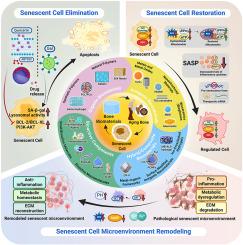Biomaterials targeting senescent cells for bone regeneration: State-of-the-art and future perspectives
IF 18
1区 医学
Q1 ENGINEERING, BIOMEDICAL
引用次数: 0
Abstract
Bone defect treatment remains a significant clinical challenge, further exacerbated by the demographic transition toward an aging society. In elderly populations, the increased proportion of senescent cells emerges as a fundamental determinant that substantially compromises regenerative outcomes. In senescent bone tissues, the progressive accumulation of senescent cells compromises bone regenerative capacity through multifaceted mechanisms, encompassing both intrinsic functional impairment of senescent cells and the far-reaching impact of the senescence-associated secretory phenotype (SASP) on the surrounding cellular and tissue microenvironment. Advanced biomaterials provide a platform for targeted anti-senescence interventions. One strategy is the selective elimination of senescent cells, achieved by engineering materials as delivery systems for senolytics or as platforms that modulate immune clearance. A more nuanced approach seeks functional rejuvenation, using biomaterials to restore cellular homeostasis by mitigating inflammation, correcting metabolic dysfunction, and reprogramming gene expression. A holistic strategy remodels the senescent microenvironment itself, accomplished through materials designed to restore biochemical homeostasis, provide physical guidance, and reprogram biological communication. This review delineates these material-based strategies, from direct cellular targeting to comprehensive niche remodeling. We also evaluate the significant hurdles to clinical translation, including challenges in biological specificity, preclinical model fidelity, and regulatory pathways. Ultimately, this work provides a conceptual framework for designing next-generation biomaterials to regenerate aging bone tissues.

针对衰老细胞的骨再生生物材料:最新的和未来的观点
骨缺损治疗仍然是一个重大的临床挑战,进一步加剧了人口结构向老龄化社会的转变。在老年人群中,衰老细胞比例的增加是影响再生结果的基本决定因素。在衰老的骨组织中,衰老细胞的逐渐积累通过多方面的机制损害骨再生能力,包括衰老细胞的内在功能损伤和衰老相关分泌表型(SASP)对周围细胞和组织微环境的深远影响。先进的生物材料为靶向抗衰老干预提供了平台。一种策略是选择性消除衰老细胞,通过工程材料作为抗衰老药物的递送系统或调节免疫清除的平台来实现。一种更细致入微的方法是寻求功能恢复,使用生物材料通过减轻炎症、纠正代谢功能障碍和重编程基因表达来恢复细胞稳态。整体策略重塑衰老微环境本身,通过设计材料来恢复生化稳态,提供物理指导,并重新编程生物通信。本文综述了这些基于材料的策略,从直接细胞靶向到全面的生态位重塑。我们还评估了临床翻译的重大障碍,包括生物特异性、临床前模型保真度和调节途径方面的挑战。最终,这项工作为设计下一代再生老化骨组织的生物材料提供了一个概念框架。
本文章由计算机程序翻译,如有差异,请以英文原文为准。
求助全文
约1分钟内获得全文
求助全文
来源期刊

Bioactive Materials
Biochemistry, Genetics and Molecular Biology-Biotechnology
CiteScore
28.00
自引率
6.30%
发文量
436
审稿时长
20 days
期刊介绍:
Bioactive Materials is a peer-reviewed research publication that focuses on advancements in bioactive materials. The journal accepts research papers, reviews, and rapid communications in the field of next-generation biomaterials that interact with cells, tissues, and organs in various living organisms.
The primary goal of Bioactive Materials is to promote the science and engineering of biomaterials that exhibit adaptiveness to the biological environment. These materials are specifically designed to stimulate or direct appropriate cell and tissue responses or regulate interactions with microorganisms.
The journal covers a wide range of bioactive materials, including those that are engineered or designed in terms of their physical form (e.g. particulate, fiber), topology (e.g. porosity, surface roughness), or dimensions (ranging from macro to nano-scales). Contributions are sought from the following categories of bioactive materials:
Bioactive metals and alloys
Bioactive inorganics: ceramics, glasses, and carbon-based materials
Bioactive polymers and gels
Bioactive materials derived from natural sources
Bioactive composites
These materials find applications in human and veterinary medicine, such as implants, tissue engineering scaffolds, cell/drug/gene carriers, as well as imaging and sensing devices.
 求助内容:
求助内容: 应助结果提醒方式:
应助结果提醒方式:


